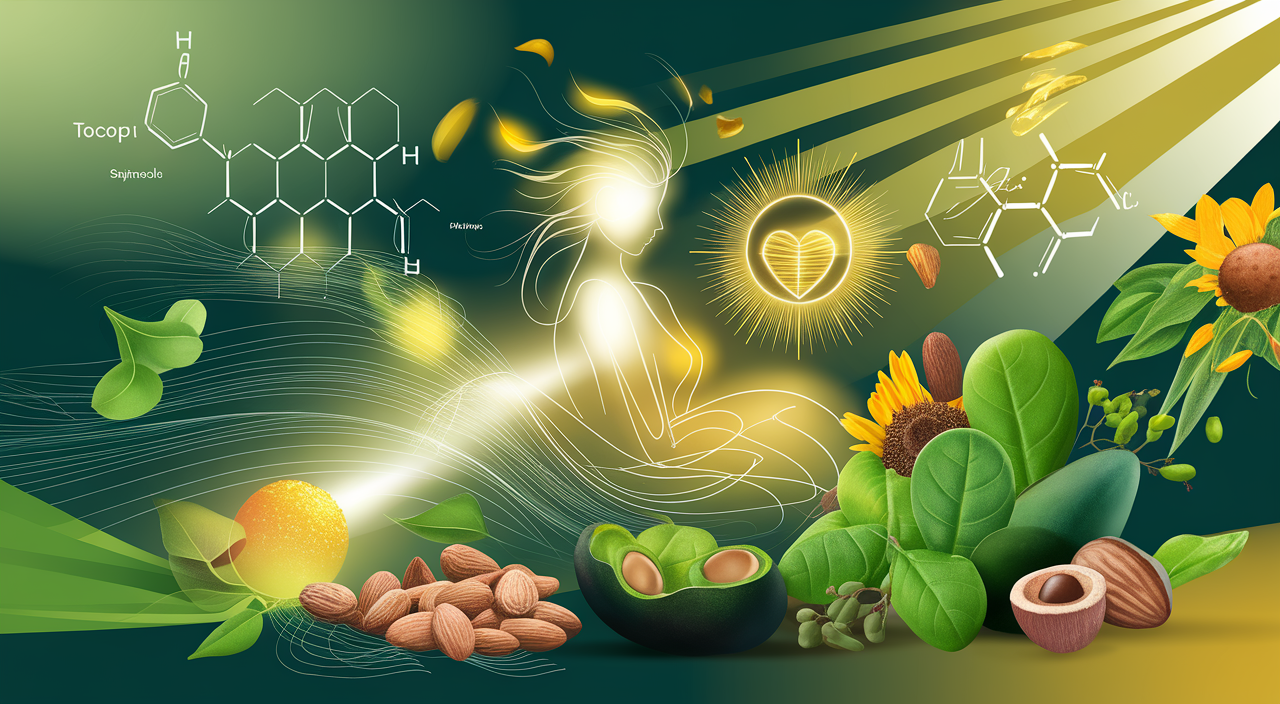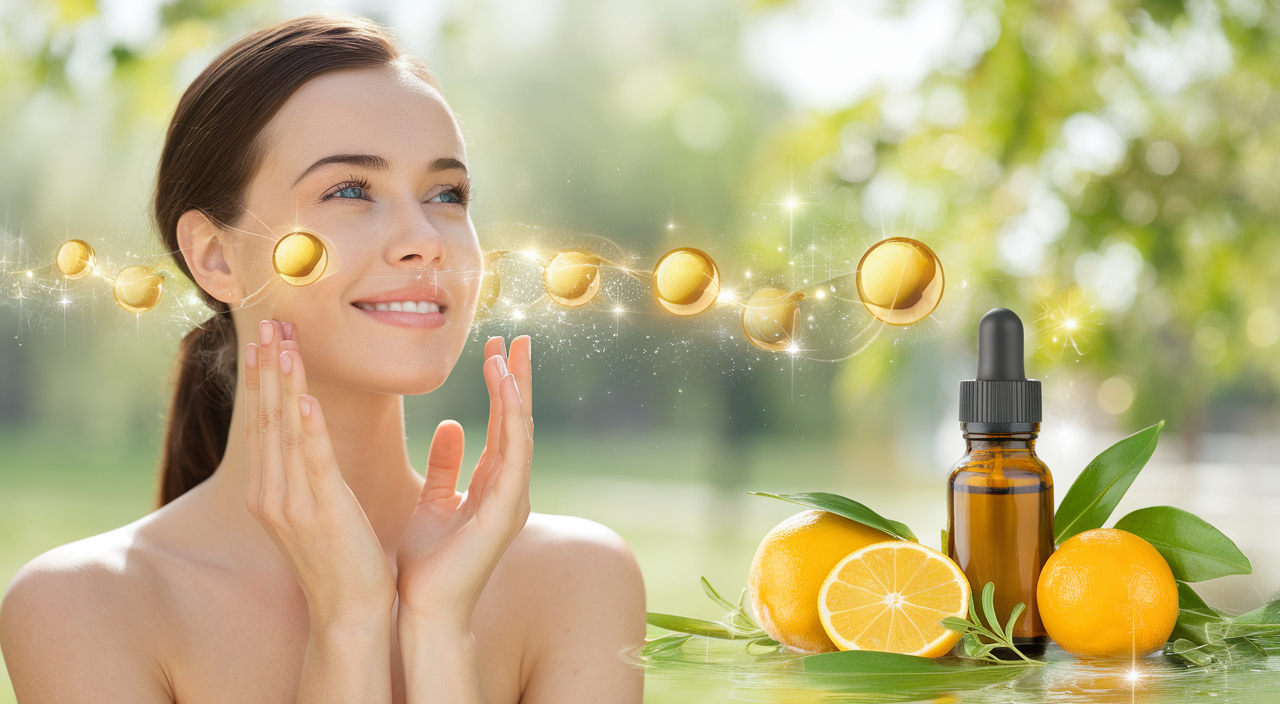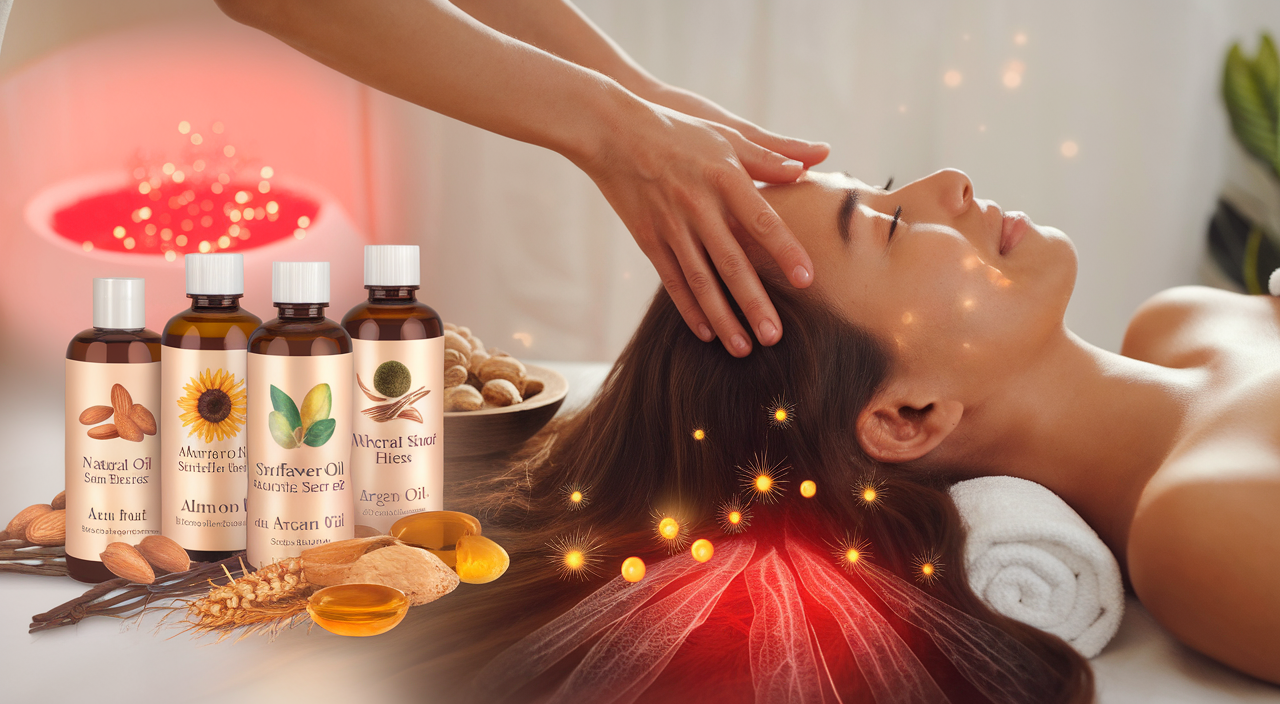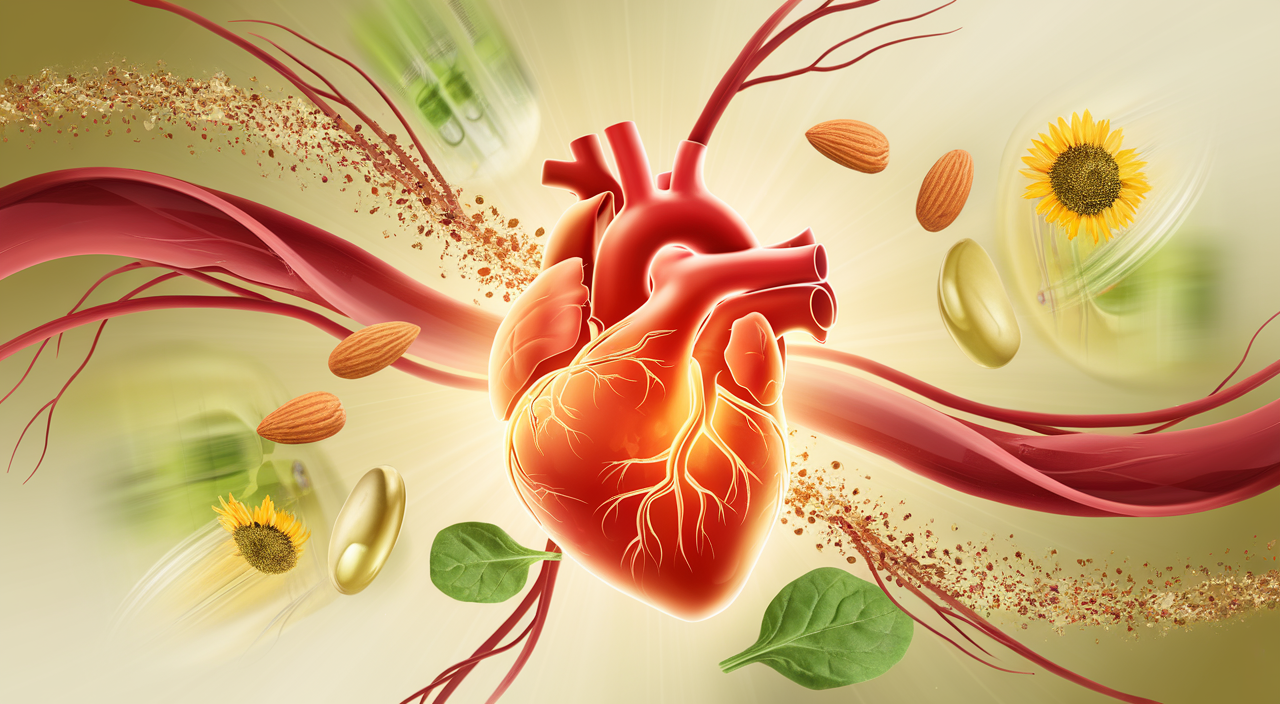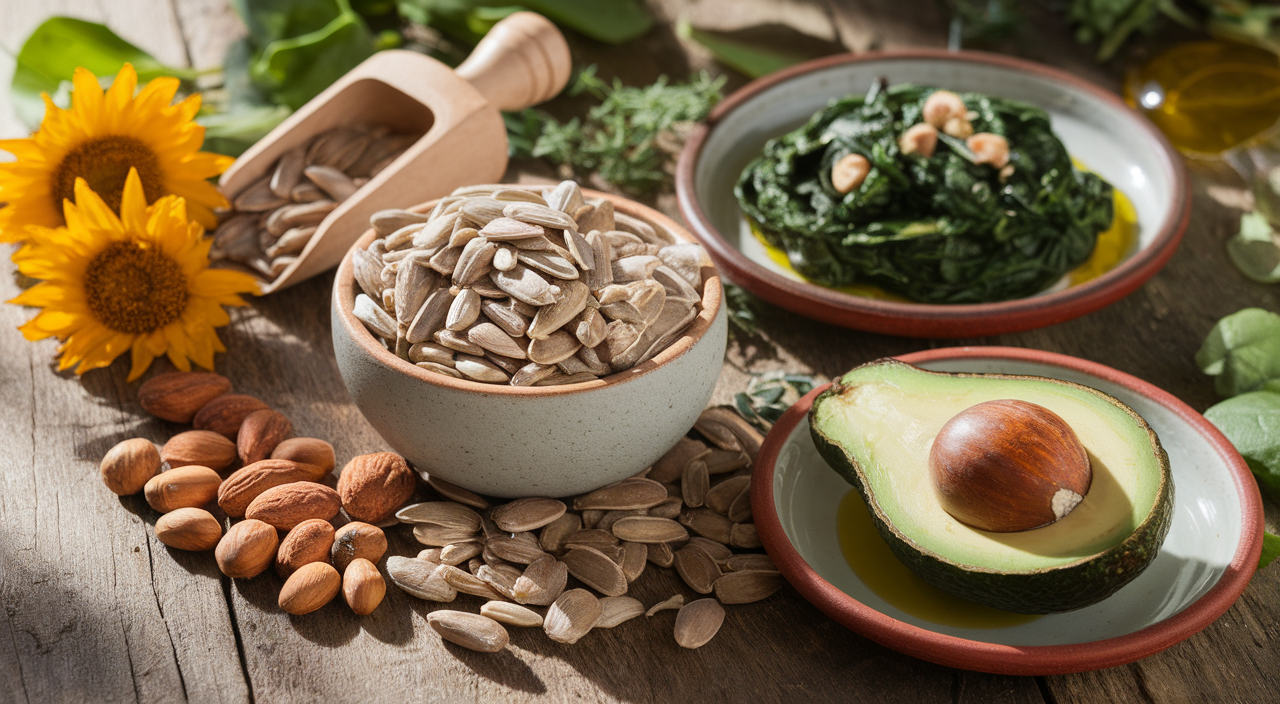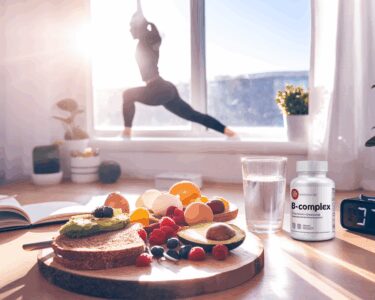Vitamin E serves as one of nature’s strongest antioxidants, protecting cells from oxidative damage while enhancing skin, hair, and heart health. This fat-soluble nutrient comes in two primary forms—tocopherols and tocotrienols—providing complete protection from cellular membranes to visible improvements in appearance.
Key Takeaways
- Adults require 15 mg of Vitamin E daily to support immune function, skin health, blood vessel strength, and vision.
- Natural Vitamin E (d-alpha-tocopherol) is twice as effective as synthetic forms, with maximum recommended intake capped at 1,000 mg daily.
- Rich dietary sources include sunflower seeds (7.4 mg per ounce), almonds (7.3 mg per ounce), hazelnuts, spinach, and avocados.
- Vitamin E works synergistically with Vitamin C, creating a powerful combination that enhances UV protection and skin repair.
- Beyond beauty benefits, Vitamin E supplementation can reduce non-fatal heart attack risk by 25% and boost hair growth by 34.5% over eight months.
Your Body’s Most Powerful Beauty & Wellness Antioxidant
The Science Behind Vitamin E’s Antioxidant Power
Vitamin E stands out as a fat-soluble powerhouse that fights oxidative damage in your body. I’ve found that this essential nutrient works alongside other antioxidants to create a protective shield for your cells, similar to how balanced skin microbiome protects your complexion. Your body cleverly uses Vitamin E to neutralize harmful free radicals, preventing them from damaging healthy cells.
The two main forms of Vitamin E – tocopherols and tocotrienols – each bring unique benefits to your health and appearance. While alpha-tocopherol gets most of the attention, tocotrienols deserve spotlight for their superior absorption and effectiveness. Think of them as the dynamic duo of cellular protection.
Daily Requirements and Benefits of Vitamin E
Getting enough Vitamin E daily is crucial for maintaining optimal health, much like how preventing premature aging requires consistent care. Adults need 15 mg of alpha-tocopherol daily to support:
- Cell membrane protection
- Immune system function
- Skin health maintenance
- Blood vessel strength
- Vision support
I’ve noticed that combining Vitamin E with other nutrients amplifies its benefits. For instance, pairing it with red light therapy can enhance skin healing. Your body better absorbs Vitamin E when consumed with healthy fats, making it perfect to include in your main meals.
The beauty benefits of Vitamin E are particularly impressive. This antioxidant helps maintain skin elasticity and can reduce the appearance of scars, working similarly to how somatic healing repairs tissue damage. Whether applied topically or taken as a supplement, Vitamin E supports your skin’s natural repair processes.
The best Vitamin E supplements often combine different forms of the vitamin for maximum effectiveness. Look for products that include both tocopherols and tocotrienols to get the full spectrum of benefits. Taking your supplement with a meal that contains healthy fats can boost absorption rates by up to 50%.
Remember to watch for signs of adequate Vitamin E intake: healthy skin, strong nails, and resilient hair are good indicators. While deficiency is rare in healthy adults, certain conditions might require additional supplementation.
Why Your Skin Craves Vitamin E
Powerful Protection Against Sun Damage
Vitamin E stands as one of nature’s most effective shields against UV radiation. I’ve found that this potent antioxidant can reduce sunburn severity by 20% when applied topically. While exploring natural ways to combat skin aging, Vitamin E emerges as a crucial defender of skin cells against environmental damage. The skin’s upper epidermis can experience up to 50% depletion of Vitamin E when exposed to environmental stressors, making regular supplementation essential.
Vitamin E’s Synergistic Effects for Skin Health
The magic of Vitamin E truly shines when paired with other skin-loving nutrients. I’ve noticed remarkable results when combining Vitamin E with Vitamin C — this dynamic duo creates a powerful antioxidant network that’s particularly effective for maintaining healthy skin balance. The combination enhances photoprotection and helps maintain skin moisture levels more effectively than either vitamin alone.
Vitamin E delivers multiple benefits for skin health:
- Locks in moisture by strengthening the skin barrier
- Reduces visible signs of aging like fine lines
- Supports skin cell regeneration
- Protects against oxidative stress
- Enhances the effectiveness of sunscreen
For optimal absorption, I recommend applying Vitamin E products after red light therapy treatments. This antioxidant can penetrate deep into the skin layers, where it works to neutralize free radicals and support cellular repair. When incorporating Vitamin E into your skincare routine, consistency is key — daily application helps maintain adequate levels in the skin’s protective barrier.
The best Vitamin E supplements for skin health typically contain the natural form (d-alpha-tocopherol) rather than synthetic versions. I’ve seen impressive results combining topical Vitamin E with holistic healing approaches for comprehensive skin health improvements. By protecting against UV damage while simultaneously supporting skin hydration, Vitamin E proves indispensable for maintaining healthy, resilient skin.
Transform Your Hair Growth Journey with Vitamin E
The Science Behind Vitamin E and Hair Growth
I’ve seen remarkable results when incorporating Vitamin E into hair care routines. Research shows a significant 34.5% boost in hair count after just 8 months of Vitamin E supplementation. This powerful antioxidant works by improving blood circulation to the scalp, creating an optimal environment for healthy hair growth. The enhanced blood flow delivers essential nutrients directly to hair follicles, making natural hair restoration possible.
Vitamin E’s role in protecting hair follicles from oxidative stress can’t be overstated. It acts as a shield against free radicals that can damage hair cells and slow down growth. Plus, it helps maintain the scalp’s natural oil production, which is crucial for keeping hair moisturized and preventing breakage.
Natural Sources and Application Methods
The best Vitamin E supplement for hair growth often comes from natural sources. Here’s what I recommend incorporating into your hair care routine:
- Argan oil – Rich in Vitamin E and fatty acids
- Wheat germ oil – One of the highest natural sources of Vitamin E
- Sunflower oil – Contains abundant Vitamin E and helps prevent hair loss
- Almond oil – Packed with Vitamin E and proteins for stronger strands
For maximum benefits, I suggest combining Vitamin E supplementation with therapeutic light treatments for enhanced results. The combination of internal and external application creates a comprehensive approach to hair growth. While applying these oils directly to your scalp, gentle massage helps stimulate circulation further.
Many people don’t realize that Vitamin E works synergistically with other nutrients. When paired with proper scalp care routines, it can enhance the overall health of your hair follicles. For those experiencing hair thinning, a holistic approach that includes both Vitamin E supplementation and stress management techniques often yields the best results.
When selecting a Vitamin E supplement specifically for hair growth, look for products containing both tocopherols and tocotrienols – these different forms of Vitamin E work together to provide maximum benefits for your hair’s health and growth potential.
Protect Your Heart Naturally with Vitamin E
Heart Attack Prevention with Vitamin E
Research shows Vitamin E can reduce your risk of non-fatal heart attacks by 25% when taking 400 IU daily. This powerful antioxidant acts as a shield for your cardiovascular system, much like how red light therapy benefits heart health. I’ve found that Vitamin E plays a crucial role in protecting LDL cholesterol from oxidation – a key factor in preventing heart disease.
The impact of Vitamin E on cholesterol levels is significant, showing a 15% reduction in total cholesterol over just 4-8 weeks. While maintaining healthy skin through proper skincare and microbiome balance is important, Vitamin E’s internal benefits for heart health are equally valuable.
Blood Vessel Protection and Anti-inflammatory Benefits
Vitamin E’s anti-inflammatory properties make it essential for blood vessel health. Just as somatic healing can reduce inflammation, Vitamin E works to protect your blood vessels from inflammatory damage. I recommend combining Vitamin E with vitamin C capsules for enhanced antioxidant protection.
Here are the key cardiovascular benefits of Vitamin E:
- Prevents arterial plaque buildup
- Reduces inflammation in blood vessels
- Improves blood flow throughout the body
- Supports overall heart muscle function
- Helps maintain healthy blood pressure levels
Taking the best Vitamin E supplement at the right time can maximize these heart-protective benefits. Like preventing skin aging, protecting your heart requires consistent care and the right nutrients. I suggest taking Vitamin E supplements with a meal containing healthy fats to enhance absorption and effectiveness.
The combination of Vitamin E and K benefits your cardiovascular system by supporting proper blood clotting while protecting vessel walls. When selecting a Vitamin E supplement, look for one containing mixed tocopherols for comprehensive heart protection.
Nature’s Best Sources for Glowing Health
Top Vitamin E Food Sources for Daily Nutrition
I’ve discovered that getting enough Vitamin E through natural food sources can make a significant impact on your health and appearance. Just like preventing premature skin aging, consuming adequate Vitamin E plays a crucial role in maintaining overall wellness.
Sunflower seeds pack an impressive punch with 7.4 mg of Vitamin E per ounce, making them my top recommendation for a quick and convenient source. I love adding them to morning smoothies or sprinkling them over salads for an instant nutrient boost.
Almonds follow closely behind, containing 7.3 mg of Vitamin E per ounce. These versatile nuts can boost your daily intake while supporting healthy skin balance. They’re perfect for snacking or adding to your favorite recipes.
Lesser-Known Vitamin E Powerhouses
Hazelnuts deserve more attention in the Vitamin E conversation, offering 4.3 mg per ounce. Combined with natural healing therapies, these nuts can enhance your body’s recovery processes.
Cooked spinach provides 3.7 mg of Vitamin E per half cup, making it an excellent option for those looking to increase their intake through vegetables. I recommend pairing it with avocados, which contain 2.1 mg per 100g, to create a nutrient-rich meal that supports whole-body wellness.
Here’s a quick breakdown of these Vitamin E-rich foods and their recommended serving sizes:
- Sunflower seeds: 1 oz serving (7.4 mg)
- Almonds: 1 oz handful (7.3 mg)
- Hazelnuts: 1 oz portion (4.3 mg)
- Cooked spinach: ½ cup serving (3.7 mg)
- Avocado: 100g serving (2.1 mg)
By incorporating these natural sources of Vitamin E into your daily diet, you’ll be supporting your body’s antioxidant needs while promoting healthy skin, strong immunity, and optimal cellular function.
Smart Supplementation Secrets for Vitamin E
Natural vs Synthetic Vitamin E Benefits
I’ve found that natural d-alpha-tocopherol packs twice the punch compared to its synthetic counterpart when it comes to Vitamin E supplementation. This powerhouse nutrient plays a crucial role in maintaining healthy skin, which is vital for your skin’s microbiome balance. When selecting supplements, I always recommend checking the label — natural Vitamin E is listed as “d-alpha-tocopherol,” while synthetic forms show up as “dl-alpha-tocopherol.”
Essential Dosage Guidelines and Safety
The maximum daily intake for Vitamin E shouldn’t exceed 1,000 mg per day. I’ve noticed many people aren’t aware that Vitamin E can support natural skin aging prevention when used correctly. However, doses above 400 IU daily need careful consideration. Like the red light therapy benefits, Vitamin E’s effects can be optimized with proper dosing.
Here are critical safety considerations for Vitamin E supplementation:
- Start with lower doses (100–200 IU) and gradually increase if needed
- Monitor for any unusual bleeding or bruising
- Check with your healthcare provider if you’re on blood thinners
- Consider taking Vitamin E with meals to boost absorption
- Track your total Vitamin E intake from both food and supplements
If you’re dealing with stress-related health issues, combining Vitamin E with somatic healing practices might enhance its benefits. I’ve seen that timing your Vitamin E supplement intake with meals containing healthy fats can significantly improve absorption. For those taking blood-thinning medications, extra caution is needed as Vitamin E can intensify their effects.
The best vitamin E supplement choice depends on your specific needs, but I always suggest starting with a high-quality natural form at a moderate dose. Remember that more isn’t always better — the key lies in consistent, appropriate dosing rather than maximum amounts.
The Beauty-Boosting Power Duo
Vitamin E and Vitamin C: A Powerful Synergy
I’ve found that Vitamin E works exceptionally well when paired with Vitamin C, creating an impressive antioxidant duo that amplifies their individual benefits. The science behind this combination is fascinating – Vitamin C actively helps regenerate Vitamin E after it neutralizes free radicals, making it ready for action again. This partnership is particularly beneficial for those looking to prevent premature skin aging signs.
Research shows that combining 15% Vitamin C with 1% Vitamin E provides substantial UV protection, making it an excellent addition to your sun protection routine. While this combination doesn’t replace sunscreen, it adds an extra layer of defense against environmental damage and helps maintain healthy skin barrier function.
Maximizing Vitamin E Benefits in Your Beauty Routine
To get the most out of this potent combination, I recommend incorporating both nutrients in your skincare and diet. Here’s how to effectively use Vitamin E with Vitamin C:
- Apply Vitamin C serum first, allowing it to absorb for 60 seconds
- Layer Vitamin E product next for enhanced protection
- Use in the morning for maximum antioxidant defense
- Look for products containing stabilized forms of both vitamins
- Consider taking Vitamin E supplements alongside Vitamin C supplements
When shopping for beauty products, I suggest looking for stabilized forms of Vitamin E (listed as tocopherol or tocopheryl acetate) paired with L-ascorbic acid (Vitamin C). These formulations ensure maximum efficacy and longer shelf life. For those interested in advanced skincare treatments, this combination can enhance results when used consistently.
The benefits of this Vitamin E and C partnership extend beyond just skin protection. This dynamic duo supports collagen production, helps fade dark spots, and contributes to a more radiant complexion. I’ve noticed that patients who consistently use both vitamins in their skincare routine often report improved skin texture and enhanced overall skin health.
For optimal results, pair topical applications with dietary sources of both vitamins. Include nuts, seeds, and leafy greens for Vitamin E, alongside citrus fruits and berries for Vitamin C. This inside-out approach maximizes the beauty-boosting benefits of both nutrients.
Incorporating nuts and seeds into your diet can boost your intake of powerful antioxidants like those found in certain dietary supplements that support immune function and skin health.
Sources:
National Institutes of Health Office of Dietary Supplements – Vitamin E Fact Sheet
Indian Dermatology Online Journal, 2016
Tropical Life Sciences Research, 2010
American Journal of Clinical Nutrition, 2004
Journal of Investigative Dermatology, 1998
Nutrition Reviews, 2010
Journal of the American Medical Association (JAMA), 2008



